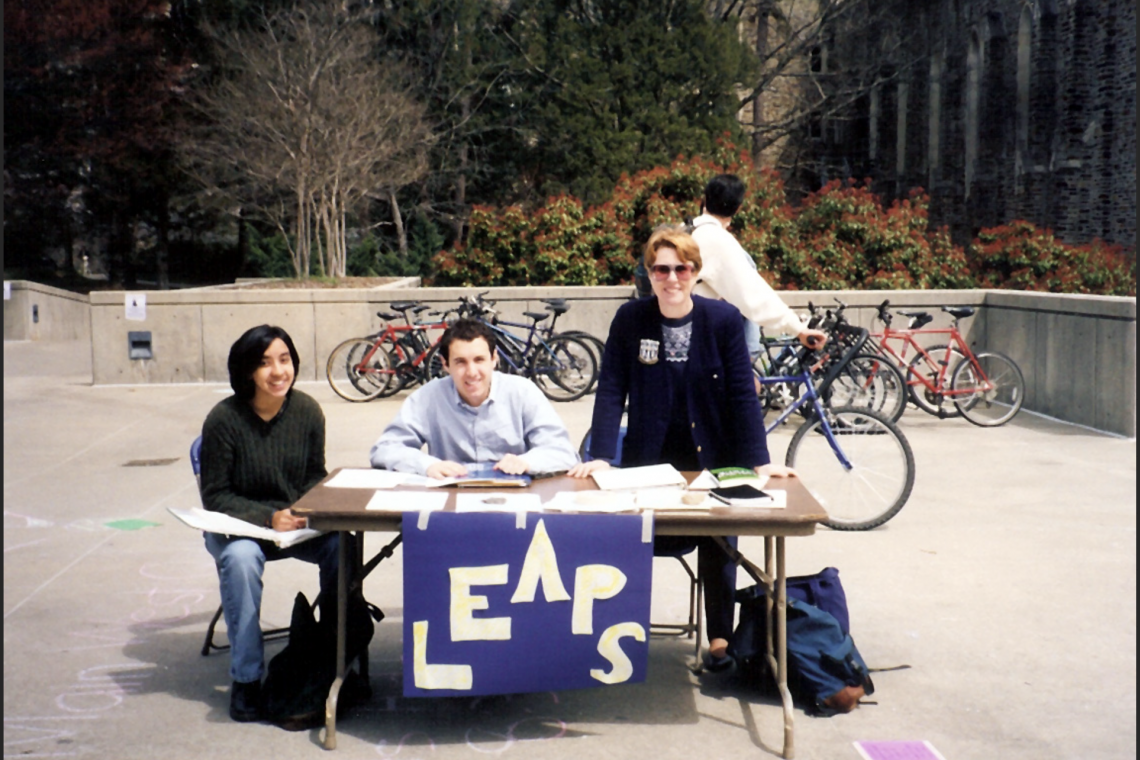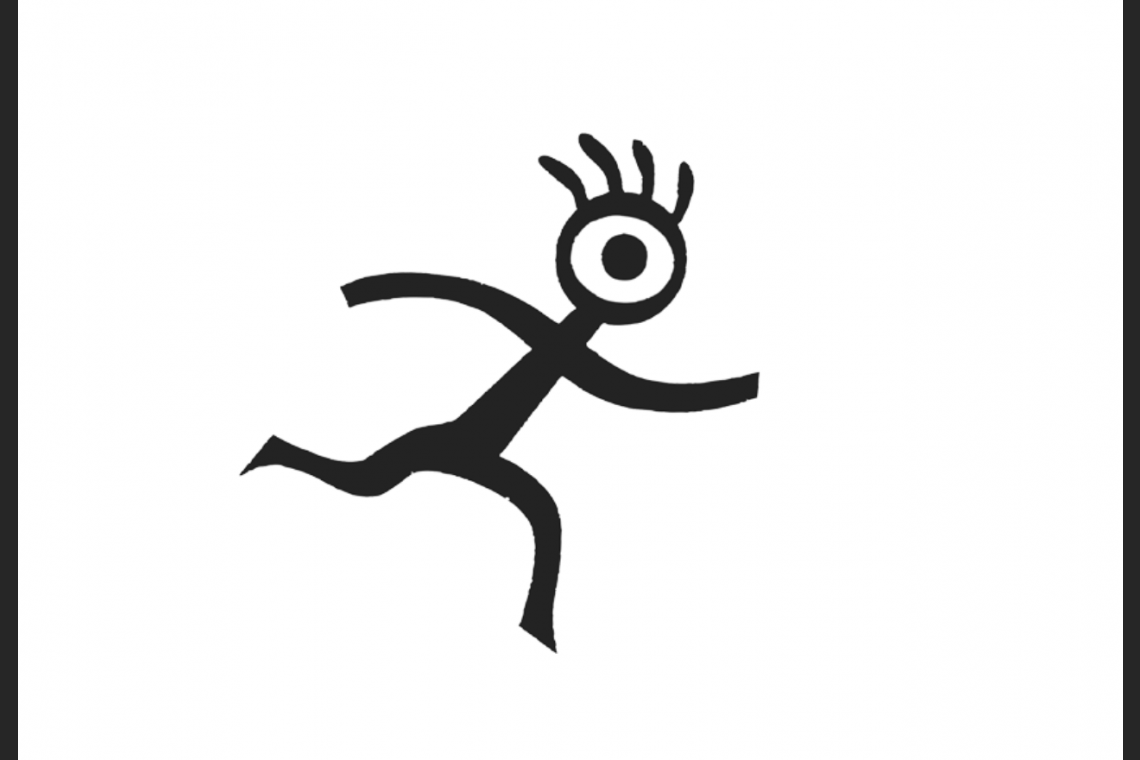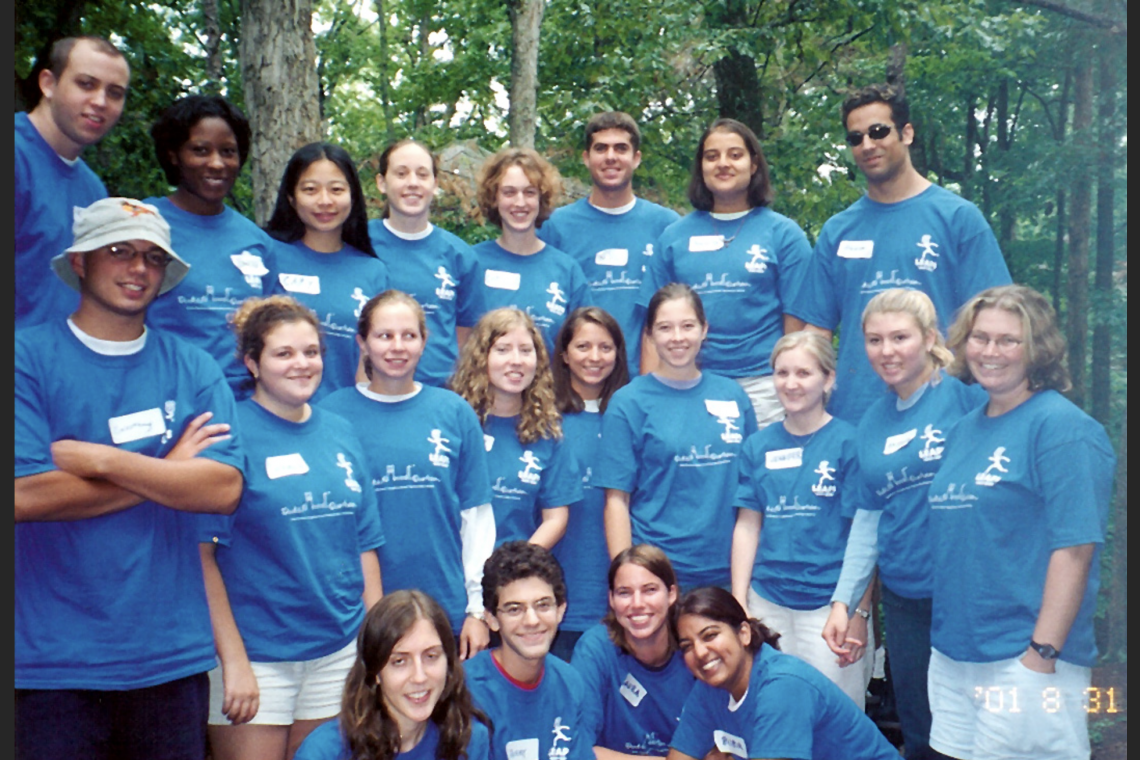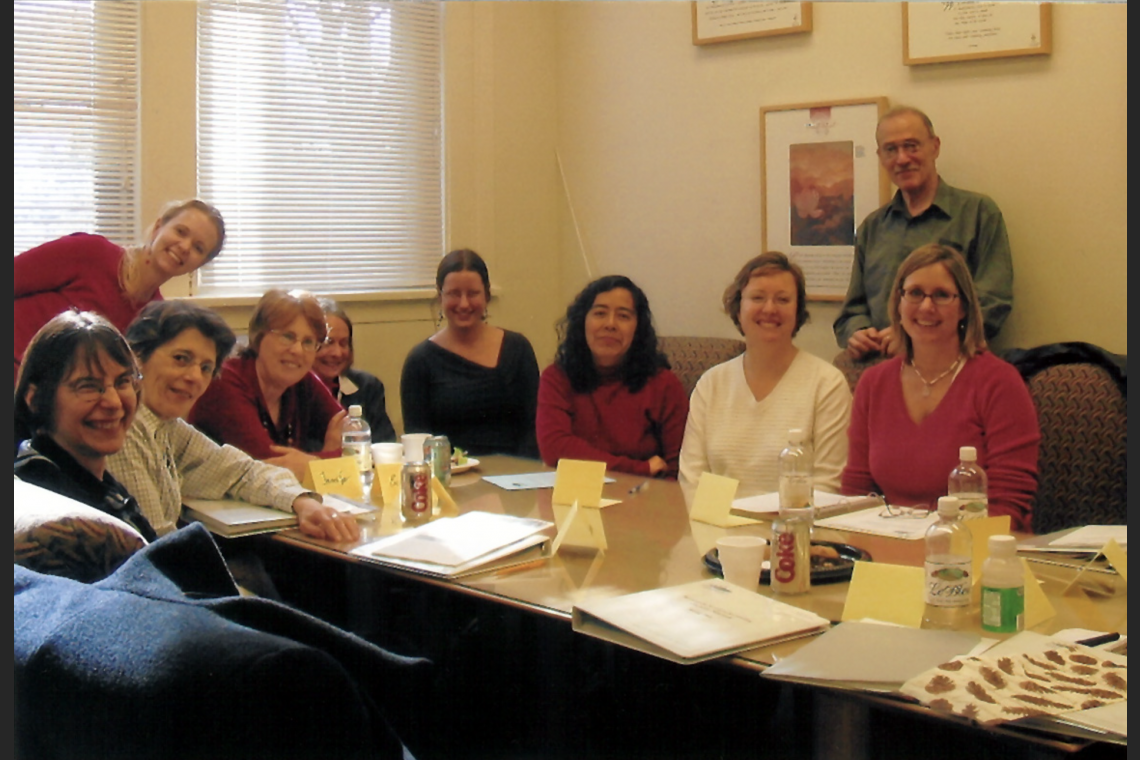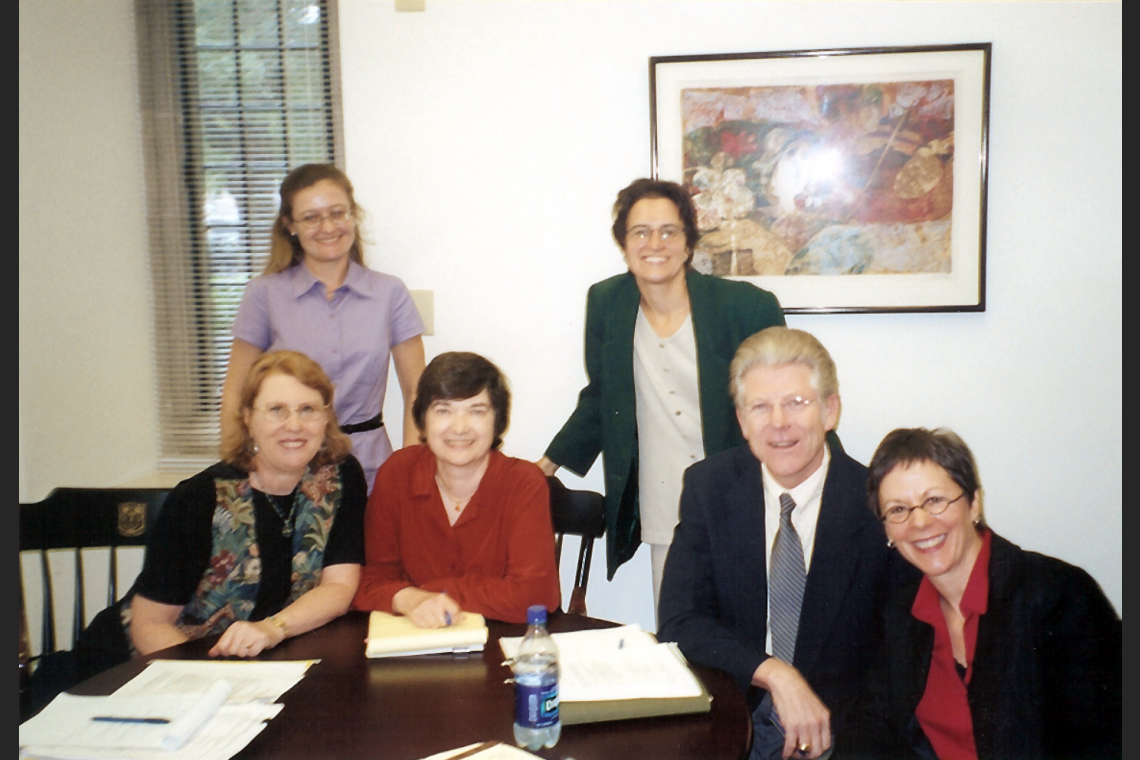When two sophomores with a bold vision meet a trailblazing pioneer of service-learning, they spark a new era of community-engaged education at Duke.

As Duke celebrates its Centennial, we’re reminded that one of its enduring and impactful educational initiatives began not in lecture halls or administrative offices, but around a kitchen table.
In 1995, two sophomores, Glenn Gutterman and Dan Kessler, noticed something missing from their Duke education: real-world connection. Their quest to bridge this gap would eventually lead them to Betsy Alden, known affectionately at Duke as the "Soul Mother of Service-Learning.” Together, they would shape a new approach to integrating academics with community-engagement.
The timing was serendipitous—a convergence of the right people, the right ideas, and the right moment. Alden, initially at Duke for a one-year campus ministry exchange, brought decades of experience, including establishing service-learning programs at college campuses nationwide and pioneering models that blended academic rigor with community engagement. When Elizabeth Kiss, the newly appointed director of the Kenan Institute for Ethics at that time, went looking for someone to help integrate ethics into undergraduate education, Duke's chaplain, Will Willimon, made a fortuitous connection: "The woman who wrote the book on service-learning happens to be at Duke this semester.”
“Elizabeth emailed me the next day,” recalls Alden. “We went to the Mad Hatter's Café for lunch and suddenly I had a new job. Just like that. It was meant to be. No question.”
Soon, Betsy's home became an unofficial headquarters for what would become LEAPS (Learning through Experience, Action, Partnership, and Service). In a departure from the formal settings of classrooms and campus meeting spaces, her kitchen table offered a relaxed and welcoming environment that encouraged collaboration. Over countless pizzas and late-night discussions, students and faculty worked to bridge the gap between academic theory and community impact. "That's how you get to know people," Alden reflects. "It's comfortable and convenient...we'd pick up something to eat, and then we could settle in, take our time and just work."

From these informal gatherings, the service-learning movement began to spread across campus. Gutterman and Kessler, armed with passion and persistence, became unlikely ambassadors for educational innovation. They approached professors they knew and respected, making the case for integrating community service into their courses. Their pitch was simple but powerful: learning becomes deeper and more meaningful when students can apply classroom theories to real-world challenges. They offered to handle the logistics and facilitate student reflection sessions as trained Service-Learning Assistants—a support model that continues today. Their belief in the vision—and their willingness to put in the work to make it happen—was contagious.
Forward-thinking faculty members like Professors Deborah Gold (Department of Sociology) and David Malone
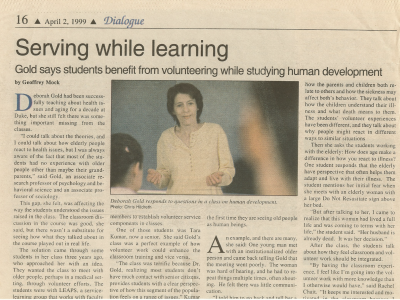
(Program in Education) embraced the vision. Gold's service-learning course "Death & Dying" exemplified the approach, with students training as hospice assistants to bring knowledge to life. “I could talk about the theories, and I could talk about how elderly people react to health issues, but I was always aware of the fact that most of the students had no experience with older people other than maybe their grandparents,” Gold explained in a 1999 Duke Dialogue interview.
During these early years at Duke, most classes followed a traditional format: professors lectured, students took notes. The challenges of changing this approach were significant. Community service had always been seen as separate from academics at Duke, relegated to Student Affairs rather than integrated into the classroom. At a research university where faculty advancement primarily depended on publications and research, convincing professors to redesign their courses around service-learning principles required more than just enthusiasm---it required proof that this approach could deepen academic learning while serving community needs.
"Our early efforts to establish experiential community-based learning at Duke were often met with reluctance – even opposition," recalls Malone. "But Betsy had a gift for showing how hands-on learning could transform both students and their education. Her approach – combining academic rigor with genuine care for students and community – helped win over even the most hesitant faculty members."
"Those initial early adopters - faculty like David Malone and Professor Gold - had to essentially go out on a limb for us," Kessler recalls. "We knew there was only so far that we could go on our own."
Institutional support proved pivotal in transforming LEAPS from informal gatherings to a sustainable academic program. The Kenan Institute for Ethics provided grants for faculty developing service-learning courses, expanding the grassroots effort into a campus-wide movement. Vice Provost for Undergraduate Education Bob Thompson played a critical role, formalizing service-learning at Duke by creating the Office of Service-Learning in 2006 and naming David Malone as Faculty Director.

A working group under Thompson’s leadership established procedures and guidelines for labeling service-learning courses in Duke’s registration system. As one of the early faculty champions of LEAPS, Malone became a voice for service-learning across campus and on committees, sharing data, mentoring faculty, and promoting academic community engagement as a high-impact practice.
Today, as Duke enters its second century, the impact of those kitchen table gatherings continues to ripple outward. Former LEAPS students have carried the program's philosophy far beyond Durham—to London universities, urban planning offices, and public interest law firms. Each December, Betsy's mailbox fills with holiday cards from former students, now scattered across the globe but still connected by their shared experience of learning through service.
At 82, Betsy still welcomes visitors to her kitchen table, though the conversations have shifted from planning sessions to reflections on legacy. Her cherished collection of LEAPS memorabilia includes a well-traveled graduation cap decorated with signatures from generations of students—each signature representing a life touched by the simple but powerful idea that learning deepens when it serves others.

From those kitchen table gatherings in the 1990s, Duke's Service-Learning has become a cornerstone of the university's commitment to community engagement. What began with just two passionate sophomores and a handful of pioneering faculty members has expanded to include over a hundred professors across disciplines teaching service-learning courses.
Today, Duke ranks among the top five universities for community service and civic engagement, with 40% of graduating seniors completing at least one service-learning course. But as program director Joan Clifford notes, “Our strength lies in the enduring relationships we foster—building collaborations between students, faculty, and communities that have a lasting impact at Duke and beyond.”
Ask Betsy Alden about LEAPS' legacy, and she'll tell you it's about the relationships, not the statistics. "The students helped found it and build it," she reflects. "And now it's out in the world. Those people who were part of the original LEAPers are now making it happen in other ways in other places. I mean, really, it's their legacy."
Click through the photo slideshow below to explore the roots and evolution of service-learning at Duke, captured through a series of candid moments and milestones.
